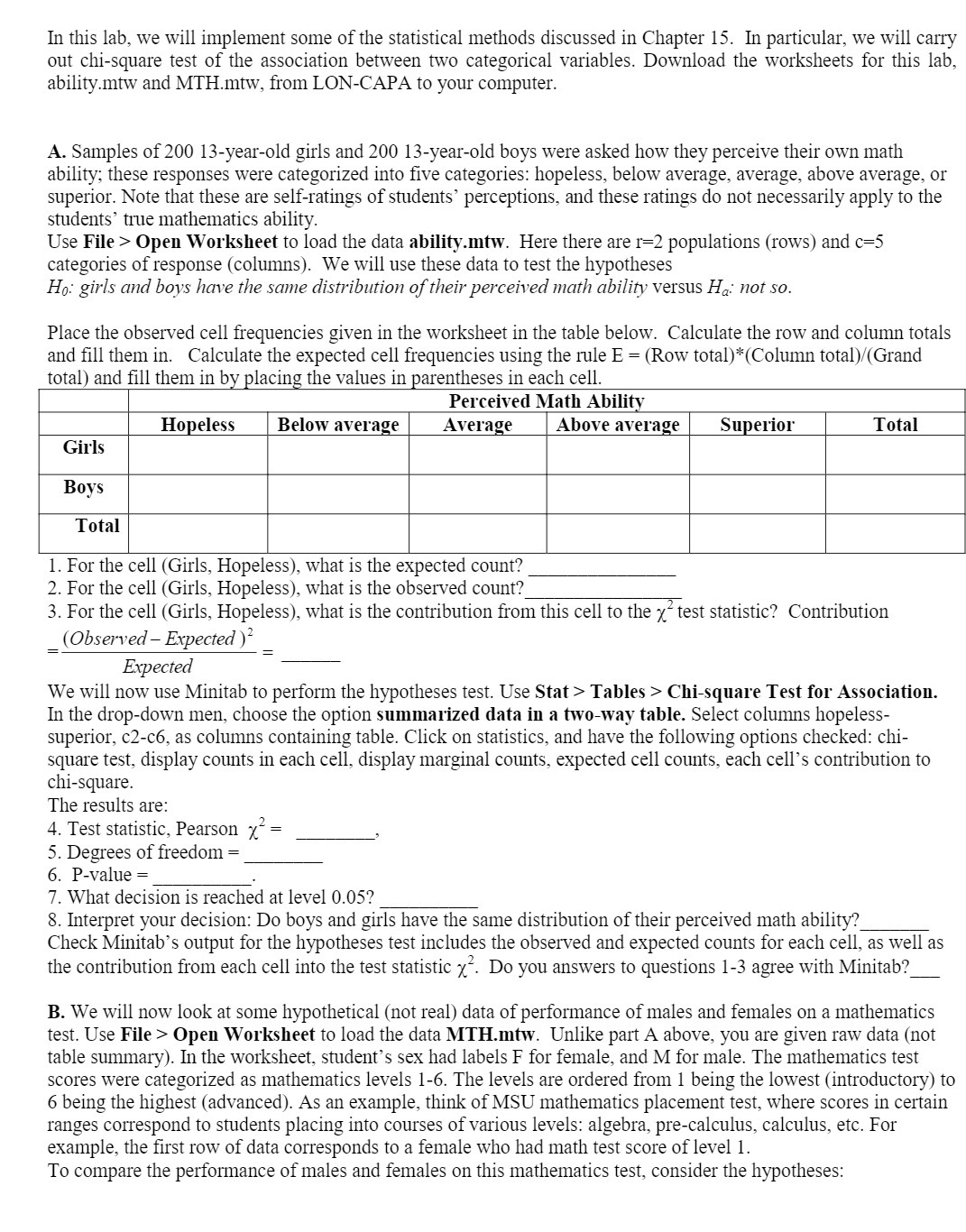In this lab, we will implement some of the statistical methods discussed in Chapter 15. In particular, we will carry out chi-square test of the association between two categorical variables. Download the worksheets for this lab, abilitymtw and MTH.mtw, from LON-CAPA to your computer. A. Samples of 200 13-year-old girls and 200 13-year-old boys were asked how they perceive their own math ability; these responses were categorized into five categories: hopeless, below average, average, above average, or superior. Note that these are self-ratings of students\" perceptions, and these ratings do not necessarily apply to the students\" nue mathematics ability. Use File > Open Worksheet to load the data ability.mtw. Here there are r=2 populations (rows) and c=5 categories of response (columns). We will use these data to test the hypotheses Hg: girls and .5qu have the same distribution oftiieir perceived math abiiiry versus Ha: not 30. Place the observed cell frequencies given in the worksheet in the table below. Calculate the row and column totals and fill them in. Calculate the expected cell frequencies using the rule E = (Row total)*(Column total)i('Grand total) and fill them in by placing the values in parentheses in each cell. Perceived Math Abili Hopeless Below average Average Superior Total Boys Total 1. For the cell (Girls, Hopeless), what is the expected count? 2. For the cell (Girls, Hopeless), what is the observed count? 3. For the cell (Girls, Hopeless), what is the contribution from this cell to the )8 test statistic? Contribution _(Obser1-'ed fig.ae.c1teri)I2 _ Expected We will now use Minitab to perform the hypotheses test. Use Stat > Tables > Chisquare Test for Association. In the drop-down men, choose the option summarized data in a two-way table. Select columns hopeless- superior, c2-c6, as columns containing table. Click on statistics, and have the following options checked: chi- square test, display counts in each cell, display marginal counts, expected cell counts, each cell's contribution to chi-square. The results are: 4. Test statistic, Pearson x2 = , 5. Degrees of freedom = 6. P-value = . 7. What decision is reached at level 0.05? 8. Interpret your decision: Do boys and girls have the same distribution of their perceived math ability? Check Minitab's output for the hypotheses test includes the observed and expected counts for each cell, as well as the contribution from each cell into the test statistic )8. Do you answers to questions 1-3 agree with Minitab? B. We will now look at some hypothetical (not real) data of performance of males and females on a mathematics test. Use File > Open Worksheet to load the data MTH.mtw. Unlike part A above, you are given raw data (not table summary). In the worksheet, student's sex had labels F for female, and M for male. The mathematics test scores were categorized as mathematics levels 1-6. The levels are ordered from 1 being the lowest (introductory) to 6 being the highest (advanced). As an example, think of MSU mathematics placement test, where scores in certain ranges correspond to students placing into courses of various levels: algebra, pre-calculus, calculus, etc. For example, the first row of data corresponds to a female who had math test score of level 1. To compare the performance of males and females on this mathematics test, consider the hypotheses







